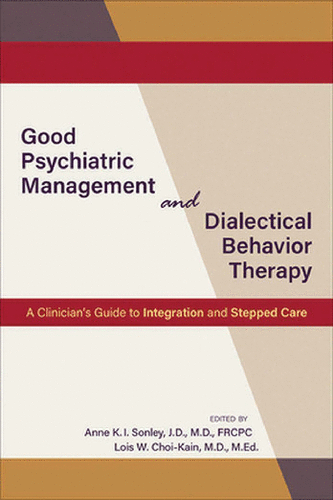Good Psychiatric Management and Dialectical Behavior Therapy: A Clinician’s Guide to Integration and Stepped Care

Edited by Anne K. I. Sonley, J.D., M.D., and Lois W. Choi-Kain, M.D., M.Ed.; Washington, D.C., American Psychiatric Association Publishing, 2021, 164 pages
Good Psychiatric Management and Dialectical Behavior Therapy, edited by Anne K. I. Sonley and Lois W. Choi-Kain, describes the application and integration of these evidence-based psychotherapies for borderline personality disorder (BPD). Good psychiatric management (GPM) was developed by McMain et al. (1) as a “generalist” model of psychotherapy that was grounded in psychodynamic and attachment theories and was suitable for the average clinician without special training. Initially called “general psychiatric management,” the model was later rebranded by Gunderson and Links (2). GPM succeeded in matching the effectiveness of dialectical behavior therapy (DBT) in a head-to-head trial (1), demonstrating that nonspecialized techniques could be effective. The editors and contributors of this volume are recognized experts in the field, well suited to the task taken up in this book.
Sonley, Choi-Kain, and other contributing writers explore “what works” in both therapies. Although GPM is different from DBT in its conceptual basis, the authors are more interested in common characteristics likely to be features of effective therapies. Both therapies are structured, manualized therapies based on underlying biopsychosocial explanatory models. Both advocate for explicitly educating patients about BPD, encourage improving function outside of therapy, and discourage dependency. Both prioritize the therapeutic relationship, conceived in both therapies as active, engaged, validating, and open to thoughtful self-disclosure.
In this book, the reader will find a clear, concise explanation of these treatment approaches. The chapter by Choi-Kain et al. makes an intriguing addition to the literature on these treatment approaches, describing how a stepped care model can be integrated with established psychotherapeutic approaches. The authors clearly describe this innovative approach to how intensity of treatment can be matched to severity and complexity. Perhaps controversially, the authors suggest that patients who show little improvement in treatment should be offered treatment consisting of supportive therapy and case management, as opposed to more aggressive treatment or use of intensive resources.
In keeping with the tone of compassion and respect present throughout this book, the authors repeatedly address the concern that patients with BPD often are misunderstood by clinicians and receive treatments that are not well suited to their needs. The authors advocate for clear education about diagnosis, treatment, and biological and environmental influences contributing to personality pathology. They recommend a highly active approach during treatment, including explicit, collaboratively chosen goals; markers for improvement or regression; and clear consequences for nonadherence, behavior that interferes with treatment, and failure to improve in treatment. Use of emergency room and hospital interventions as well as distress tolerance skills are explained in detail.
Chapters 5 and 6 present toolkits for the implementation of DBT and GPM, respectively. McMain and Sonley give an admirable summary of the key concepts and techniques of DBT. In this concise yet thorough chapter, they explain challenging concepts, such as the dialectic in DBT, in which apparent opposites are accepted and held in productive tension. Skills training and other important tools in DBT are fully described, as is the role of the relationship with the DBT therapist. Overall, this chapter clearly and efficiently lays out the most important principles and techniques of DBT.
Sonley and Links collaborate in explaining GPM. Perhaps to avoid repetition with earlier chapters, these authors begin with a lengthy explanation of effective prescribing in the treatment of BPD. Although this explanation is useful and well written, I found myself searching the text to understand GPM better as a psychotherapeutic modality. The authors then briefly discuss the interpersonal focus of GPM and quickly return to “focus on function.” I would have appreciated more discussion of how GPM can contribute to the clinician’s understanding of the patient and can help clarify relational and emotional difficulties.
Sonley and Choi-Kain draw the book to a close with detailed, clear, and thoughtfully written case illustrations. The authors conclude with the parting message that three of the most important things a clinician can do in treating patients with BPD are “to provide them with psychoeducation about the disorder, help them set goals around building a ‘life worth living’ and help them make connections between emotions, thoughts, and behaviors.” In demonstrating how GPM and DBT can complement and inform each other’s practice, Sonley and Choi-Kain have provided an original and useful work. Illuminated by the authors’ respect for the struggles of patients with BPD and the spirit of helpful support for therapists, this book is likely to be a useful companion for psychotherapists and for clinicians in general practice.
1 : A randomized trial of dialectical behavior therapy versus general psychiatric management for borderline personality disorder. Am J Psychiatry 2009; 166:1365–1374Crossref, Medline, Google Scholar
2 : Handbook of Good Psychiatric Management for Borderline Personality Disorder. Washington, DC, American Psychiatric Association Publishing, 2014Google Scholar



